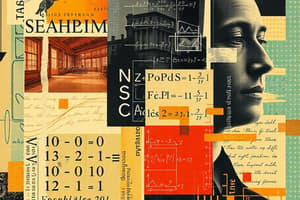Podcast
Questions and Answers
What is a key characteristic of mathematical language according to the text?
What is a key characteristic of mathematical language according to the text?
- Informal
- Random
- Powerful (correct)
- Verbose
Which type of symbols does Mathematics use instead of words?
Which type of symbols does Mathematics use instead of words?
- Hieroglyphics
- Symbols (correct)
- Alphabets
- Emojis
- Logograms
What types of values do lowercase letters typically represent in Mathematics?
What types of values do lowercase letters typically represent in Mathematics?
- Counting values (correct)
- Fractions
- Negative numbers
- Sets
What does uppercase letter convention in Mathematics typically represent?
What does uppercase letter convention in Mathematics typically represent?
What is the difference between an expression and a sentence in Mathematics?
What is the difference between an expression and a sentence in Mathematics?
How is the language of Mathematics described in terms of making distinctions?
How is the language of Mathematics described in terms of making distinctions?
Which of the following is NOT a component found in an expression?
Which of the following is NOT a component found in an expression?
What does the symbol ∈ denote in set theory?
What does the symbol ∈ denote in set theory?
Which mathematical principle does PEMDAS represent?
Which mathematical principle does PEMDAS represent?
What is a well-defined collection of objects in set theory called?
What is a well-defined collection of objects in set theory called?
Which notation method is used to describe the elements of a set by enumerating them?
Which notation method is used to describe the elements of a set by enumerating them?
What type of set has elements that are unlimited or uncountable?
What type of set has elements that are unlimited or uncountable?
Flashcards
Mathematical Language
Mathematical Language
A precise and concise system for expressing mathematical ideas using symbols instead of words.
Expression
Expression
A combination of symbols that represents a mathematical value, according to established rules.
Sentence (in math)
Sentence (in math)
A statement about two expressions, which can be either true or false.
Set
Set
Signup and view all the flashcards
Element of a set
Element of a set
Signup and view all the flashcards
Roster method
Roster method
Signup and view all the flashcards
Set Builder Notation
Set Builder Notation
Signup and view all the flashcards
Finite Set
Finite Set
Signup and view all the flashcards
Infinite Set
Infinite Set
Signup and view all the flashcards
Unit Set
Unit Set
Signup and view all the flashcards
PEMDAS
PEMDAS
Signup and view all the flashcards
Mathematical Symbol
Mathematical Symbol
Signup and view all the flashcards
Study Notes
Characteristics of Mathematical Language
- Precise: able to make very fine distinctions
- Concise: able to say things briefly; direct to the point
- Powerful: able to express complex thoughts with relative ease
Importance of Mathematical Language
- Allows easier penetration of the subject and the development of more powerful methods
- Enables efficient communication of mathematical ideas
Mathematical Language System
- Uses symbols instead of words
- Examples: basic operations (+, -, x, ÷), symbols for values (x, y), special symbols (π, =, ≤, ≥)
- Letter conventions: uppercase for sets (e.g., A = {1, 2, 3}), lowercase for variables (e.g., x, y)
Expressions and Sentences
- Expression: finite combination of symbols, well-defined according to rules
- Sentence: makes a statement about two expressions, true or false
- Examples of expressions: 2a, 1+1, 2+3
- Examples of sentences: 2a = 2, 1+1=2, 2+3=5
Conventions in Mathematical Language
- Principle of PEMDAS (Parenthesis, Exponent, Multiplication, Division, Addition, and Subtraction)
- Examples: 4x(5+3) → 4x8=32, 3 x 22 → 3 x 4= 12, 30÷5 x 3 → 6x3=18
Language of Sets
- Set theory: branch of mathematics that studies sets
- Introduced by Georg Cantor in 1870
- A set: well-defined collection of objects, elements or members of a set
- Symbol ∈ denotes element of a set, ε denotes not an element of a set
- Examples of sets: A = {x| x is a positive integer less than 10}, B = {x| x is a real number and x2-1=0}
Methods for Describing a Set
- Roster/ Listing Method/ Tabulation Method: enumerates elements separated by commas
- Set Builder Notation/ Rule Method: describes elements or members of the set {x| P(x)}
- Examples: A = {a, e, i, o, u}, E = {x| x is a collection of vowel letters}
Types of Sets
- Finite set: limited or countable elements, last element can be identified
- Infinite set: unlimited or uncountable elements, last element cannot be specified
- Unit set: set with only one element, also called singleton
- Examples: A = {x| x is a positive integer less than 10}, F = {x| x is a set of whole numbers}, J = {x| x is a whole number greater than 1 but not less than 3}
Studying That Suits You
Use AI to generate personalized quizzes and flashcards to suit your learning preferences.



